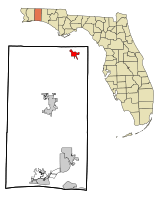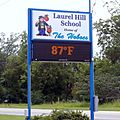Laurel Hill, Florida facts for kids
Quick facts for kids
Laurel Hill, Florida
|
|
|---|---|
| City of Laurel Hill | |

Location in Okaloosa County and the state of Florida
|
|
| Country | |
| State | |
| County | Okaloosa |
| Settled (Almirante) | 1821 |
| Platted (Almirante) | 1895 |
| Incorporated (City of Laurel Hill) |
1905 |
| Reincorporated (City of Laurel Hill) |
June 2, 1953 |
| Government | |
| • Type | Mayor-Council |
| Area | |
| • Total | 4.27 sq mi (11.05 km2) |
| • Land | 4.21 sq mi (10.89 km2) |
| • Water | 0.06 sq mi (0.16 km2) |
| Elevation | 282 ft (86 m) |
| Population
(2020)
|
|
| • Total | 584 |
| • Density | 138.85/sq mi (53.61/km2) |
| Time zone | UTC-6 (Central (CST)) |
| • Summer (DST) | UTC-5 (CDT) |
| ZIP code |
32567
|
| Area code(s) | 850 |
| FIPS code | 12-39650 |
| GNIS feature ID | 0285397 |
Laurel Hill is a small city in Okaloosa County, Florida, in the United States. It is part of a larger metropolitan area that includes cities like Crestview and Fort Walton Beach. In 2020, about 584 people lived there. This was a small increase from 537 people in 2010.
Contents
History of Laurel Hill
Early Settlements and Naming
The area where Laurel Hill is now was one of the first places in Florida settled by English-speaking people after the United States took control. People started a community here in 1821. It was first known as "Almirante."
In the 1880s, a new railroad helped the lumber industry grow in northwest Florida. The Yellow River Railroad reached the Almirante area by 1892. In 1895, Almirante was a small community focused on logging and farming. It was officially mapped out and renamed Laurel Hill. The new name supposedly came from a large laurel tree in the middle of the community.
Growth and Challenges
Laurel Hill grew quickly and became an official city in 1905. The Florida Legislature made this happen. By 1915, Laurel Hill was the biggest community in the new Okaloosa County. However, it did not become the county seat. That honor went to Crestview, which was more centrally located.
After World War I, Laurel Hill's economy slowed down. Things got worse during the Florida land boom collapse in the 1920s. This led to the closing of the city's only bank. To help the community and improve its services, Laurel Hill was officially reincorporated as a city on June 2, 1953.
The city was once served by the Louisville & Nashville Railroad. This company bought the Yellow River Railroad in 1906. However, the train line was closed and removed in the 1980s.
Community Events and Churches
Since 1992, Laurel Hill has hosted the annual Laurel Hill Hobo Festival. This fun event takes place on the first Saturday of October.
The city is home to several historic churches. These include South Ebenezer Baptist Church, Ebenezer Baptist Church, Laurel Hill Presbyterian Church, Laurel Hill First Baptist Church, and Mount Zion Baptist Church.
Geography and Climate
Location and Size
The City of Laurel Hill is located at 30°57′55″N 86°27′33″W / 30.965369°N 86.459149°W. It covers a total area of about 3.1 square miles (8.0 km2), and all of it is land. Laurel Hill is the northernmost city in the state of Florida.
Weather Patterns
The climate in Laurel Hill is known for its hot and humid summers. Winters are generally mild. According to the Köppen climate classification, Laurel Hill has a humid subtropical climate. This means it gets plenty of rain throughout the year.
Population Information
| Historical population | |||
|---|---|---|---|
| Census | Pop. | %± | |
| 1910 | 316 | — | |
| 1920 | 291 | −7.9% | |
| 1930 | 302 | 3.8% | |
| 1940 | 350 | 15.9% | |
| 1950 | 327 | −6.6% | |
| 1960 | 411 | 25.7% | |
| 1970 | 418 | 1.7% | |
| 1980 | 610 | 45.9% | |
| 1990 | 543 | −11.0% | |
| 2000 | 549 | 1.1% | |
| 2010 | 537 | −2.2% | |
| 2020 | 584 | 8.8% | |
| U.S. Decennial Census | |||
Population by Race and Ethnicity
The table below shows the different groups of people living in Laurel Hill. It compares the population from the 2010 and 2020 United States Censuses.
| Race | Pop 2010 | Pop 2020 | % 2010 | % 2020 |
|---|---|---|---|---|
| White (NH) | 439 | 452 | 81.75% | 77.40% |
| Black or African American (NH) | 86 | 71 | 16.01% | 12.16% |
| Native American or Alaska Native (NH) | 0 | 4 | 0.00% | 0.68% |
| Asian (NH) | 4 | 3 | 0.74% | 0.51% |
| Pacific Islander or Native Hawaiian (NH) | 0 | 0 | 0.00% | 0.00% |
| Some other race (NH) | 1 | 5 | 0.19% | 0.86% |
| Two or more races/Multiracial (NH) | 4 | 37 | 0.74% | 6.34% |
| Hispanic or Latino (any race) | 3 | 12 | 0.56% | 2.05% |
| Total | 537 | 584 |
In 2020, there were 584 people living in Laurel Hill. These people lived in 225 households, and 125 of these were families. In 2010, there were 537 people, 204 households, and 178 families.
Education in Laurel Hill
All public schools in Laurel Hill are part of the Okaloosa County School District.
- Okaloosa Comprehensive Head Start
- Laurel Hill School is a local school. Their sports team name is the Hoboes. It is believed to be the only school in the United States with this unique team name!
See also
 In Spanish: Laurel Hill para niños
In Spanish: Laurel Hill para niños


